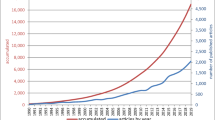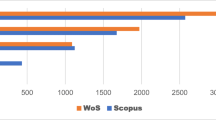Abstract
Although the research and application of a geographic information system (GIS) in bibliometrics remains in its initial stage, several valuable attempts have been made in recent years. This paper provides our overview regarding this area. We first reviewed the spatial information mining derived from literature, including structured and unstructured data. The spatial display and the basic spatial operations for the geographic information derived from literature were then introduced, demonstrating that GIS can be directly used to construct digital libraries. Some literature database websites have begun to utilize WEBGIS to display the spatial distribution of an author’s location. Additionally, the spatial distribution information can be displayed in various modes with other specialized tools. Potential spatial analyses in bibliometrics were then discussed, introducing geostatistical and buffer analyses as case studies. Finally, several bibliometric indicators attached with research units were investigated. When the quantitative research index units are linked with the research spatial position, they can be displayed, queried and retrieved spatially. Future work to advance the application and research of GIS in bibliometrics is still warranted.
Similar content being viewed by others
Explore related subjects
Discover the latest articles and news from researchers in related subjects, suggested using machine learning.References
Ahlgren P, Persson O, Tijssen R (2013) Geographical distance in bibliometric relations within epistemic communities. Scientometrics 95:771–784
Allen RS (2001) Interdisciplinary research: a literature-based examination of disciplinary intersections using a common tool, geographic information system (GIS). Sci Technol Libr 21(3–4):191–209
Allison W, Christian P (1994) GIPSY: automated geographic indexing of text documents. J Am Soc Inf Sci 45:645–655
Ancona D, Freeston M, Smith T, Fabrikant S (2002) Visual explorations for the Alexandria digital earth prototype. Börner K and Chen C (Eds.): visual Interfaces to digital libraries, LNCS 2539, pp. 199–213
Barbara PB (1998) Looking forwards: geographic information services and library in the future. Cartogr Geogr Inf Syst 25:161–171
Barbara LH (2010) Global networks in W.G. Sebald’s Rings of Saturn. In The Undiscover’d Country: W.G. Sebald and the Poetics of Travel (ed.) Markus Zisselsberger. New York
Bellis DN (2009) Bibliometrics and citation analysis: from the Science citation index to cybermetrics. Scarecrow Press, pp. 417
Bensalem I, Kholladi MK (2010) Toponym disambiguation by arborescent relationships. J Comput Sci 6:653–659
Bishop BW, Mandel LH (2010) Utilizing geographic information systems (GIS) in library research. Libr Hi Tech 28(4):536–547
Börner K (2011) Plug-and-play macroscopes. Commun ACM 54(3):60–69
Börner K, Chen C, Boyack KW (2003) Visualizing knowledge domains. Annu Rev Inf Sci Technol 37:179–255
Bornmann L, Leydesdorff L (2011) Which cities produce worldwide excellent papers more than expected? A new mapping approach—using Google Maps—based on statistical significance testing. J Am Soc Inf Sci Technol 62:1954–1962
Bornmann L, Leydesdorff L (2012) Which cities’ paper output and citation impact are above expectation in information science? Some improvements of our previous mapping approaches. J Informetrics 6:336–345
Bornmann L, Waltman L (2011) The detection of “hot regions” in the geography of science—A visualization approach by using density maps. J Informetrics 5:547–553
Bornmann L, Mutz R, Daniel HD (2008) Are there better indices for evaluation purposes than the h-index A comparison of nine different variants of the h index using data from biomedicine. J Am Soc Inf Sci Technol 59:830–837
Bornmann L, Leydesdorff L, Walch-Solimena C, Ettl C (2011) Mapping excellence in the geography of the sciences: an approach made possible by using Scopus data. J Informetrics 5:537–546
Bornmann L, Moya-Anegón F, Leydesdorff L (2012) The new excellence indicator in the world report of the SCImago institutions rankings 2011. J Informetrics 6(2):333–335
Cai G (2002) GeoVIBE: a visual interface to geographic digital library. Proceedings of Visual Interfaces to Digital Libraries, pp, 171–187, Portland
Carvalho R, Batty M (2006) The geography of scientific productivity: scaling in US computer science. J Stat Mech: Theor Exp 2006(10):P10012
Chen C, Song IY, Yuan X, Zhang J (2008) The thematic and citation landscape of data and knowledge engineering (1985–2007). Data Knowl Eng 67:234–259
French M (1999) The ARL GIS literacy project: support for government data services in the digital library. From http://www.iassistdata.org/downloads/iqvol241french.pdf
Frenken K, Hardeman S, Hoekman J (2009) Spatial scientometrics: towards a cumulative research program. J Informetrics 3:222–232
Garfield E (1998) The impact factor and using it correctly. Unfallchirurg 101:413–414
Glänzel W (2002) Journal impact measures in bibliometric research. Scientometrics 53(2):171–193
Hassan S, Haddawy P (2013) Measuring international knowledge flows and scholarly impact of scientific research. Scientometrics 97:163–179
Hengl T, Minasny B, Gould M (2009) A geostatistical analysis of geostatistics. Scientometrics 80(2):491–514
Hirsch JE (2005) An index to quantify an individual’s scientific research output. Proc Natl Acad Sci U S A 102:16569–16572
Leidner JL (2007) Toponym resolution in text: annotation, evaluation and applications of spatial grounding of place names. Dissertation.com, ISBN: 978–1581123845., pp 289
Leydesdorff L, Bornmann L (2012) Mapping (USPTO) patent data using overlays to Google maps. J Am Soc Inf Sci Technol 63(7):1442–1458
Leydesdorff L, Persson O (2010) Mapping the geography of science: distribution patterns and networks of relations among cities and institutes. J Am Soc Inf Sci Technol 61:1622–1634
Liu L, Wang XY, Li Y (2008) Research on the digital library construction based on GIS. J Inf 1:133–135
Ma D, Meng L (2009) The change of the number of troops in the Space Time Cube for the Red Army Long March. Proceedings of International Symposium on Spatial Analysis, Spatial-Temporal Data Modeling, and Data Mining (ISSA 2009) (pp. 74720X, 1–10). Wuhan
Ma TC, Cao MK, Wang GF (2011) Analysis of the regional competitiveness of basic research in China based on the National Natural Science Fundation of China. Chin Sci Bull (Chinese Ver) 56:3115–3121
Olechnicka A, Ploszaj A (2010) Mapping the regional science performance evidence from Poland. Collnet J Scientometrics Inf Manag 4:21–27
Pouliquen B, Kimler M, Steinberger R, et al. (2006) Geocoding multilingual texts: Recognition, disambiguation and visualisation. Proceedings of LREC-2006, pp, 53–58
Pritchard A (1969) Statistical bibliography or bibliometrics? J Doc 25:348–349
Schreiber M (2008) A modification of the h-index: the hm-index accounts for multi-authored manuscripts. J Informetrics 2:211–216
Smith T, Andresen D, Carver L, Dolin R, Fischer C, Frew J, Goodchild M, Ibarra O, Kemp R, Kothuri R, Larsgaard M, Manjunath B, Nebert D, Simpson J, Wells A, Yang T, Zheng Q (1996) A digital library for geographically referenced materials. Comput (IEEE) 29(5):54–60
Van Eck NJ, Waltman L (2010) Software survey: VOSviewer, a computer program for bibliometric mapping. Scientometrics 84:523–538
Vanclay JK (2012) Impact factor: outdated artefact or stepping-stone to journal certification. Scientometrics 92:211–238
Vinkler P (2010) Indicators are the essence of scientometrics and bibliometrics comments to the book entitled “bibliometrics and citation analysis, from the science citation index to cybermetrics from Nicola De bellis”. Scientometrics 85:861–866
Wang XM, Ma MG (2009) Spatial information mining and visualization for Qinghai-Tibet Plateau’s literature based on GIS. Proceedings of International Symposium on Spatial Analysis, Spatial-Temporal Data Modeling, and Data Mining (ISSA 2009) (pp. 74920T, 1–8). Wuhan
Wang XM, Li X, Ma MG, Zhang ZQ (2012) Spatial analysis on the geographical information of the scientific literature for qinghai-tibet plateau. Adv Earth Sci 27:1288–1294
Woodruff AG, Paunt C (1994) GIPSY: automatic geographical indexing of documents. J Am Soc Inf Sci Technol 45:645–655
Wu J (2013) Geographical knowledge diffusion and spatial diversity citation rank. Scientometrics 94:181–201
Zhao RY, Xu LM (2010) The knowledge map of the evolution and research frontiers of the bibliometrics. J Libr Sci China 36:60–68
Author information
Authors and Affiliations
Corresponding author
Additional information
Communicated by: H. A. Babaie
Foundation item
Under the Special Project of Literature Ability of the Chinese Academy of Sciences and the National Natural Science Foundation of China (grant no.: 40701133).
Rights and permissions
About this article
Cite this article
Xuemei, W., Mingguo, M., Xin, L. et al. Applications and researches of geographic information system technologies in bibliometrics. Earth Sci Inform 7, 147–152 (2014). https://doi.org/10.1007/s12145-013-0132-4
Received:
Accepted:
Published:
Issue Date:
DOI: https://doi.org/10.1007/s12145-013-0132-4




